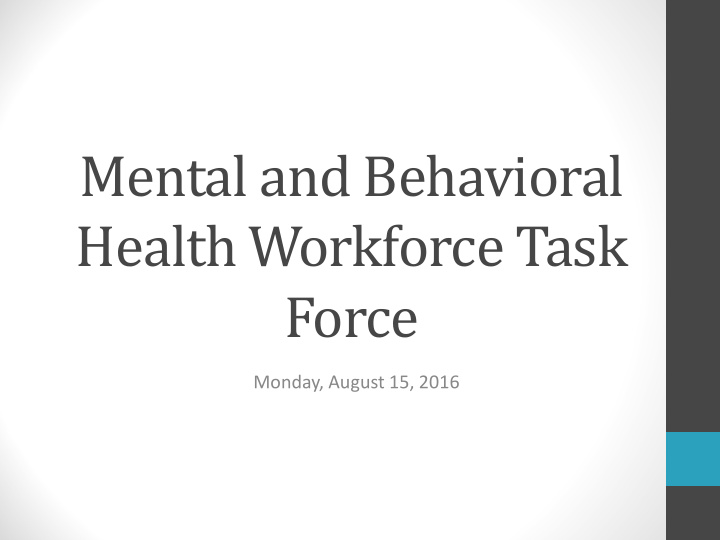



Mental and Behavioral Health Workforce Task Force Monday, August 15, 2016
WELCOME
APPROVAL OF MINUTES FROM LAST MEETING
REVIEW OF PREVIOUSLY IDENTIFIED PRIORITIES
Identified Issues • See handout for voted priorities from RedCap survey
Access Count Assess retention of talent in Indiana 3 (develop exit interview survey tool for organizations to administer) Develop strategies to address 4 telemedicine limitations under current statute Develop strategy to provide 5 Continuing Education in mental health/addiction for primary care providers Develop user-friendly, web-based 2 platform for referring providers and consumers with information on where services can be accessed
Licensing/Certification Count Designate or establish an 6 entity/credentialing body to support feasibility assessment for new and emerging workforce models, which support health system transformation and advance total patient health (including mental health and addiction). Develop competencies and 8 certification mechanisms for peer-to- peer counselors and non-licensed health professionals.
Needs Assessment Count Survey/focus groups with consumers 7 to gain consumer perspective Survey/focus groups with students to 7 gain future pipeline perspective
Reimbursements Count Administrative simplification across all 1 payers (centralized credentialing body, universal PDL, universal PA forms, monitoring UM protocols for parity compliance) Gaining Medicaid reimbursement for 9 mid-level, community health, and recovery workers Reimbursement parity with physical 4 health professionals (equivalency in reimbursement for similarly educated/licensed/trained professionals)
Which area should be the highest priority? Count Access 6 Licensing/Certification 1 Needs Assessment 4 Reimbursements 3
POLICY INITIATIVES TO SUPPORT HEALTH WORKFORCE INNOVATIONS Examples from two states
Threats • Hoosiers with mental health and addiction needs • High rates of ED utilization • Demonstrated need for addiction services • Shortage (by type, geography, practice characteristics, etc.) of mental health professionals to serve meet the mental health (primary care and oral health) needs
Issues “States must be prepared to respond to health system transformation through workforce innovations.” Barriers (identified by the task force) to addressing these threats: • Access • Licensing/Certification • Understanding Needs • Reimbursements
Model: Health Workforce Pilot Projects Program (see handout) Program Name Health Workforce Pilot Projects Program Where is it housed? Under the Office of Statewide Health Planning and Development in the Health and Human Services Agency Membership Staffed as a state agency Purpose Facilitate better access to • healthcare Expand and encourage workforce • development Demonstrate, test, and evaluate • new or expanded roles Help inform Legislature when • considering changes to existing legislation
Model: Health Workforce Pilot Projects Program
Model: Health Workforce Pilot Projects Program Outcomes: 77 Pilot Projects 173 sponsors 123 HWPP 117 HWPP have resulted in have submitted applications applications legislative applications have been have been and/or since 1972 approved administered regulatory change
Model: Health Workforce Pilot Projects Program • Strategic Strengths: • Promotes the testing of innovative workforce models • New roles • Expanding roles • Payment delivery models
Model: Board of Health Professions (see handout) Program Name Board of Health Professions Where is it housed? Alongside other licensing boards, under the Secretary of Health and Human Resources Membership 17 members: 1 member from each of the 12 separate licensing boards and 5 citizen members To improve access to safe and effective health care Purpose • To promote appropriate regulation. • To encourage resolution of disciplinary cases. • To provide a forum for debate/consensus for scope of • practice issues. To determine the need for regulation of unregulated • professions and examine emerging professions and treatments. To conduct studies mandated by the General • Assembly or requested by the public. To put appropriate information about health care • practitioners in the hands of consumers. To have a system to monitor the effect and impact of • professional regulation on the delivery of appropriate health care. To educate and inform policy makers •
Model: Board of Health Professions • Strategic Strengths: • Sunrise reviews: Evaluation of new professions to determine whether an occupation should be regulated to protect the health, safety, or welfare of the public • Sunset reviews: Evaluation of current or expiring legislation to determine whether it is still relevant • Representation of all licensing boards as well as consumers
Implications for Indiana • No mechanism(s) such as these currently in place • Many of the currently identified barriers could be addresses (to some extent) through these models • Access • Licensing/Certification • Understanding Needs • Reimbursements
What might this look like for Indiana? • “Health Workforce Innovations Board” • Review current statutes • Evaluation of pilot programs (workforce models, reimbursement mechanisms, etc.) in partnership with state agencies (example: DWD, ISDH, FSSA)
DISCUSS NEXT STEPS
Next Steps • Recommendations to the Council
ADJOURN
Next Task Force Meeting • Date: Thursday, September 15, 2016 • Time : 2:00-4:00pm • Location : Government Center South, Conference Room C Next Council Meeting • Date: Thursday, September 1, 2016 • Location: 302 W. Washington St. Indianapolis, IN 46204 Government Center South, Conference Room A
Recommend
More recommend